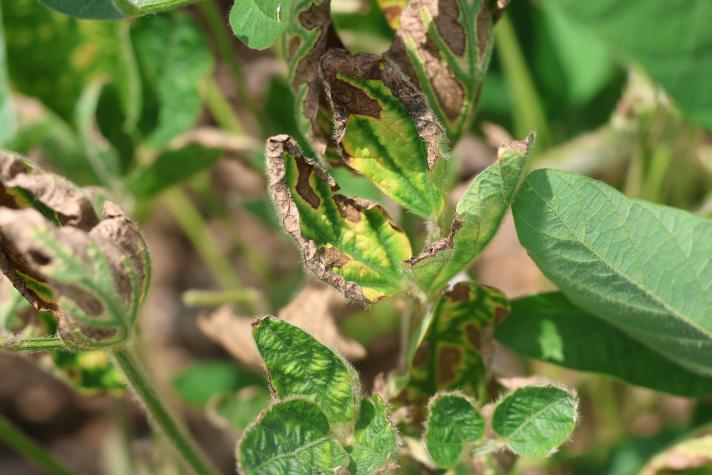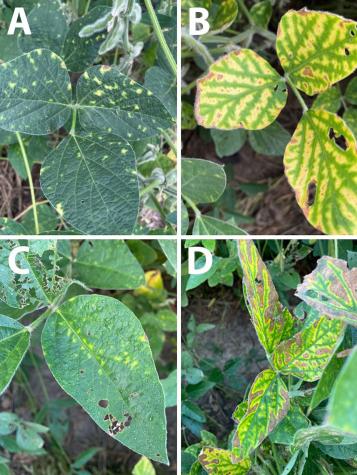Scout soybean fields now for the disease.
COLUMBIA, Mo. – University of Missouri Extension specialists confirmed red crown rot (RCR) in soybean fields in Maries and Phelps counties in early August, says University of Missouri Extension state plant pathologist Mandy Bish. RCR can cause yield losses of up to 80% in affected areas.
The state’s first case of red crown rot was confirmed last summer in Marion County in northeastern Missouri.
Now is the time to scout fields, says Bish. RCR typically occurs in nonuniform patches within fields. When scouting, look for groups of infected plants in wet or low-lying parts of the field, she says.
The disease is caused by the soilborne fungus Calonectria ilicicola. Leaf symptoms typically appear during the reproductive stages (usually R3 or after). Leaves of infected plants show yellowing between veins (interveinal chlorosis).
But checking leaves is not enough, says Bish, because leaf symptoms strongly resemble those of sudden death syndrome (SDS) disease. As the disease progresses, leaves can become necrotic and die. RCR-infected leaves tend to remain attached to the plant’s petioles, while SDS-infected leaves tend to fall off the plant.
To distinguish RCR from SDS and other lookalike diseases, dig the plant up to look at the roots and split the stem. RCR-infected stems will show reddening at the stem base, severe root rot and tiny red reproductive structures (perithecia) near the top of the root and stem base. Plants can be infected with both RCR and SDS.
“Once red crown rot spreads, you cannot unspread it,” says Bish. Soybean and disease specialists know of no cure, though seed treatments may reduce symptoms and infection. Foliar fungicides are ineffective, she says.
Some practices may reduce severity: planting into cooler soils, cleaning equipment when leaving an infected field and rotating to a non-host crop such as corn for at least two years to reduce inoculum in the soil. No soybean seed varieties are known to be resistant to RCR, although some may be more tolerant than others.
Missouri Soybean Merchandising Council supports MU Extension efforts to study RCR, including work to culture the RCR pathogen. These cultures will be used to study the infection process and screen soybean varieties and breeding lines for resistance.
Bish asks that you contact your local MU Extension agronomist if you suspect RCR in your fields, or the MU Plant Diagnostic Clinic to help with diagnosis of the disease.
You can follow the spread of red crown rot and other plant diseases at the Crop Protection Network.
Photo
RCR and SDS
Foliar symptoms alone can’t differentiate between red crown rot (RCR) and sudden death syndrome (SDS). Photos A and B show plants with RCR. Photos C and D show a plant with SDS. Photos courtesy of Mandy Bish.

